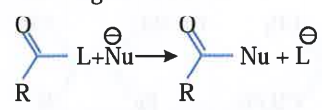Which gives nucleophilic addition reactions ?
CH3CHO
CH2=CH2
CH3−O−CH3
CH3−CH2
The correct Answer is:A
Due to presence of strong electronegative O-atom, the carbon-oxygen double bond in carbonyl group 
becomes highly polarised. This makes C-atom of the carbonyl group electron deficient, hence it undergoes nucleophilic addition reaction.
Topper's Solved these Questions
- GENERAL ORGANIC CHEMISTRY BOOK - ERRORLESSCHAPTER - GENERAL ORGANIC CHEMISTRY EXERCISE - NCERT BASED QUESTIONS (Structural and Stereo Isomerism )
99 Videos
- GENERAL ORGANIC CHEMISTRY BOOK - ERRORLESSCHAPTER - GENERAL ORGANIC CHEMISTRY EXERCISE - PAST YEARS QUESTIONS
85 Videos
- GENERAL ORGANIC CHEMISTRY BOOK - ERRORLESSCHAPTER - GENERAL ORGANIC CHEMISTRY EXERCISE - NCERT BASED QUESTIONS (Dipole Moment, Resonance and Reaction Intermediates )
70 Videos
- ENVIRONMENTAL CHEMISTRYBOOK - ERRORLESSCHAPTER - ENVIRONMENTAL CHEMISTRYEXERCISE - ASSERTION & REASON
7 Videos
- HYDROCARBONSBOOK - ERRORLESSCHAPTER - HYDROCARBONSEXERCISE - ASSERTION & REASON
18 Videos
Similar Questions
Knowledge Check
An aldehyde can give nucleophilic addition reaction with :
AHCNBNaHSO3CR-Mg-XDNH2NH2Statement-1: Aldehyde and ketone give nucleophilic addition reactions with carbon oxygen, nitrogen and sulphur nucleophiles.
Statement-2: Sulphite ion is ambident nucleophile.AStatement-1 is True, Statement-2 is True, Statement-2 is a correct explanation for statement-4Bstatement-1 is true, statement-2 is true, statement-2 is NOT a correct explanation for statement-4Cstatement-1 is true, statement-2 is falseDstatement-1 is false, statement-2 is trueWhich of the following is most reactive towards nucleophilic addition reactions ?
ACH3COCH3BCH3CHOCCH3COC2H5DHCHO
Which of the following aldehydes is most reactive towards nucleophilic addition reactions ?
View SolutionWhich of the following is most reactive towards nucleophilic addition reactions ?
View SolutionWhich of the following compounds is most reactive towards nucleophilic addition reactions ?
View SolutionAldehydes and ketones are amphoteric. Thus they can act both as acids and bases. Under acidic conditions, the carbon of the protonated canbonyl group is much more electrophilic, reacting even with weak nucleopphilie. Carbonyl compound gives nucleophilic addition reaction. In this reaction the nucleophilic attack proceeds the elecrophilic attack.
Carbonyl compounds gives nucleophilic addition with
View SolutionAldehyde, ketone, carboxylic acid derivatives contain C= O group. Aldehyde and ketones give nucleophilic addition reactions where as acid and acid derivatives give nucleophilic addition followed by elimination reactions. Nucleophilic addition reactions followed by elimination of acid dervatives is Known sacyl substitution reaction. This substitution reaction takes place by formation of tetrahedral intermediate. For the given reaction

which of these is correct ?
View Solution
